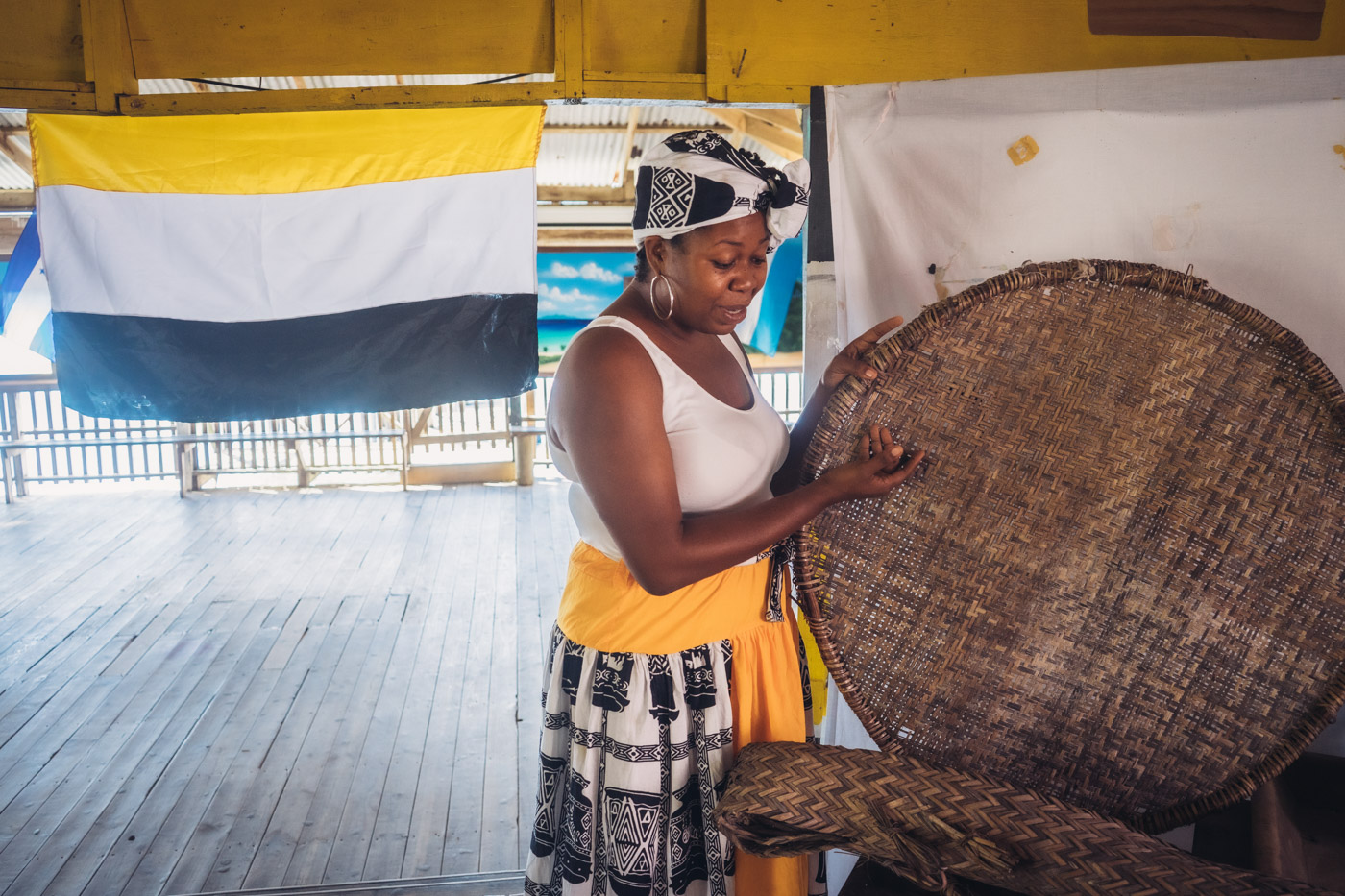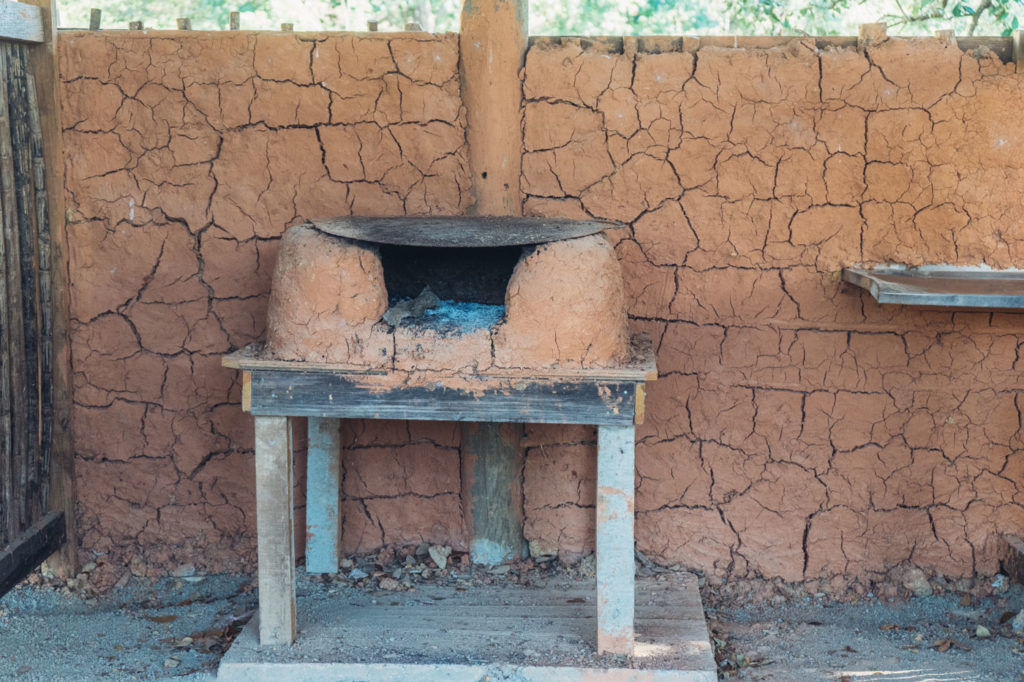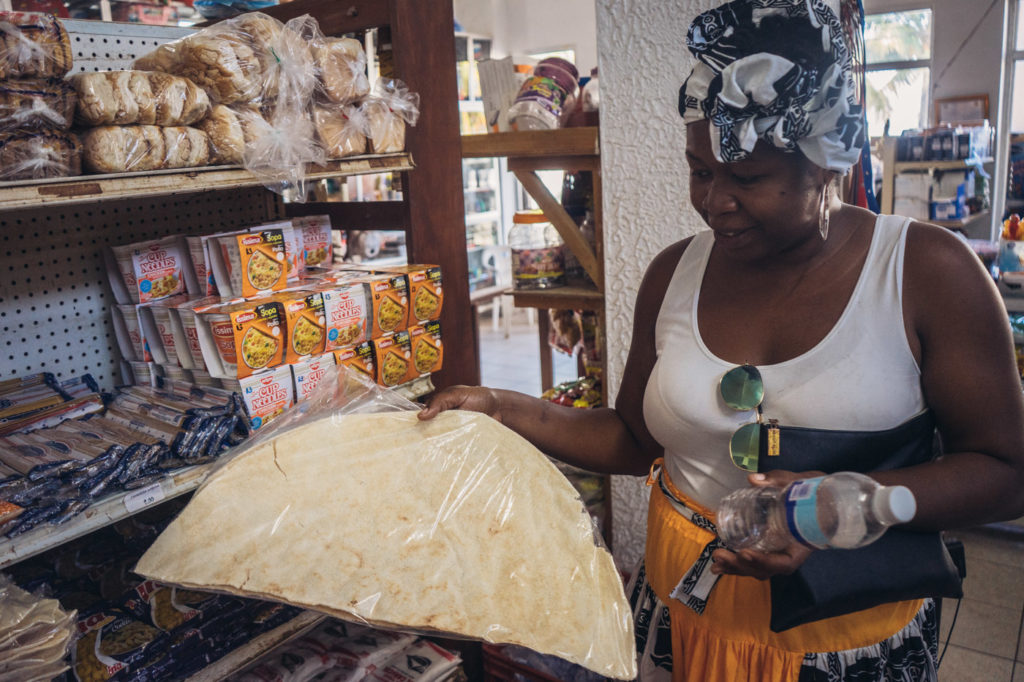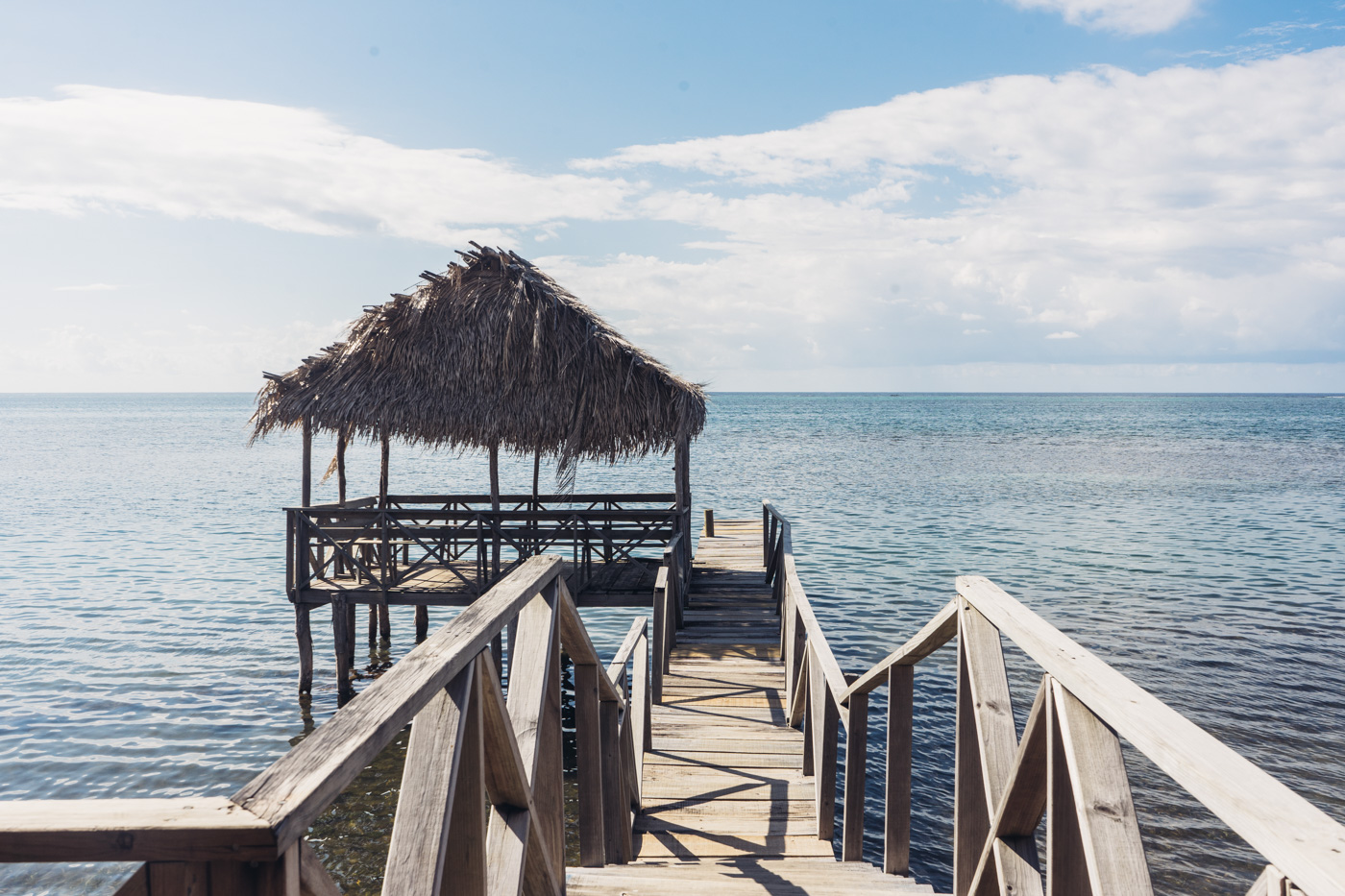“The British called this slave food,” Audrey Flores explains matter-of-factly as she breaks off a large, crispy chunk of cassava bread for me to try. “Personally, I think it goes great with tuna,” she adds. “But everyone around here has their own way of enjoying cassava bread.”
Flores is the director of the Flamingo Cultural Center, an institution on the Honduran island of Roatán dedicated to preserving the heritage, culture and cuisine of the island’s Garifuna community. Originally from Brooklyn, New York, Flores relocated to Roatán in 2011 in search of her Garifuna roots. Almost a decade later, Flores works to record and revitalize the traditions of the cassava-growing community in the village of Punta Gorda, from which the world’s modern-day Garifuna diaspora can trace their common ancestry.
The story of the Garifuna people doesn’t begin in Roatán, however. It begins some 1,700 miles to the east on the Caribbean island of St. Vincent. Claiming descent from shipwrecked and runaway African slaves who cohabitated and procreated with the Arawak population on St. Vincent beginning in the 1630s, the Garifuna people established an independent culture, but inevitably and tragically came into conflict with expanding European colonial powers.
After a series of brutal wars, the defiant Garifuna people were exiled from their homeland and sent across the Caribbean Sea to be marooned on the uninhabited shores of Roatán. The British left the Garifuna to die, but with the help of a few smuggled cassava seeds, they not only survived, but thrived.

___
Overlooking the Caribbean Sea from the stilted, wooden verandah of the cultural center, Flores encourages me to try more cassava bread. “We eat cassava bread all the time,” she says enthusiastically. “I see it as a low-fat tortilla, but lots of people smother it in butter and garlic and bake it in the oven.”
The name “Garifuna” is derived from an old Arawak word meaning “cassava-eaters,” and cassava bread and its elaborate preparation remains an important part of Garifuna identity to this day. Known in the Garifuna language as “areba,” this large, round flatbread is prepared from grated, baked cassava roots and is central to the Garifuna story.
While the Garifuna identified themselves through their cassava-eating habits, Europeans separated the population on St. Vincent by race, rather than culinary preferences. In his book, The Black Carib Wars: Freedom, Survival and the Making of the Garifuna, historian Christopher Taylor notes that the Garifuna were “known to antagonists and allies alike as Black Caribs, a name which encapsulates their mixed African/Amerindian heritage.” The Black Caribs were defined in opposition to those who were referred to as Yellow Caribs, who also lived on St. Vincent and who the British viewed as being purely Indigenous, rather than having African heritage.
While the term “Black Carib” was never used by the Garifuna people, their African and Arawak heritage has always been a source of pride. Taylor points out: “The Garifuna story is unique. While the history of all but the most recently arrived Black populations of the Americas passes through the experience of slavery, Garifuna people take pride in their past as a free people living for generations according to their own customs on St. Vincent.”
This independent streak didn’t sit well with the British, as their planters sought control of the fertile Garifuna lands on St. Vincent for the construction of lucrative sugar plantations. After two centuries of perpetual conflict (which the British labeled “The Black Carib Wars”), the Garifuna were defeated in 1797. Deemed too unruly to ever be fully subdued, the Garifuna were exiled from their homeland to the uninhabited island of Roatán.
Flores recounts the arduous history of her ancestors. “They were simply kicked out of their homes by the British. Many died on the journey, and many more left for mainland Honduras as soon as they arrived here. At the time, Roatán was the furthest island from British possession in the Caribbean. They wanted to get rid of the Garifuna, so they sent them here to die.”
Almost unknown outside of Garifuna communities, Taylor remarks in his book how significant the 1797 deportation was: “The defeat and deportation of the Black Caribs marked the effective end not just of their presence on St. Vincent, but of an entire way of life in the islands of the Caribbean.” Taylor goes on to say: “St. Vincent was the site of the last battle of people living a traditional lifestyle against the European colonialists anywhere in the islands. It was here that the Caribbean saw its Little Big Horn and its Wounded Knee.”
The tragic deportation marked the beginning of another difficult chapter in the Garifuna story. Taylor gives the number of Garifuna men, women and children abandoned on Roatán as 2,026. Held in squalid, disease-ridden conditions before the deportation, Taylor writes, “This small band represented virtually all that was left of the Black Carib people, less than half the number who had surrendered in St. Vincent just a few months earlier.”


___
“My ancestors brought cassava bread with them here from St. Vincent,” Flores explains at the cultural center in Roatán. The tranquil setting in which we’re having our conversation, as the Caribbean Sea laps against the palm-lined beach below the veranda, stands in stark contrast to the tumultuous tale of Flores’ ancestors.
Flores encourages me to try more cassava bread as we take in the view, mentioning happily how it also tastes great with fried fish. It’s the sort of staple that goes well with anything; it can be eaten on its own as a snack, dipped in sauces, or served up as part of a main course. Given our location, it’s no surprise that seafood and cassava bread are a favorite combination in Punta Gorda.
I take another bite. It’s not dissimilar in taste or texture from the poppadoms I grew up enjoying in Indian restaurants in the United Kingdom—crunchy, and a little plain in flavor when eaten by itself. It’s slightly salted and definitely compelling, I realize, as I keep breaking off more chunks while watching a fishing boat heading toward shore. Unfortunately, we haven’t got any spare cans of tuna, fried fish, or garlic butter on hand for me to sample Flores’ pairing suggestions.
“It became incredibly important,” says Flores, as she continues the story of cassava bread. “Because you can store cassava bread for years if you have to.”
Long-lasting cassava bread survived the arduous journey from St. Vincent, and future crops would see the Garifuna people through times of unpredictable harvests as they adjusted to their new surroundings. Hardy and drought-resistant cassava crops became not only a source of valuable nutrients to the exiled, but also a valuable link to their increasingly distant past on St. Vincent, where their ancestors had grown the crop for centuries.
Flores suggests the possibility that her ancestors smuggled cassava seeds on the journey to Roatán. James L. Sweeney, a researcher of the Black Carib Wars, embellishes this local story when he writes in his article “Caribs, Maroons, Jacobins, Brigands, and Sugar Barons: The Last Stand of the Black Caribs on St. Vincent”: “According to legend, the Garifuna (or ‘Cassava Eaters’) on the exile ships hid cassava inside their clothing. They were able to plant it on Roatán, and continue to use it as a basic stable.”
Taylor notes from British records in The Black Carib Wars, “With them the British landed supplies deemed sufficient to last the Caribs six months,” including such items as “sweet potatoes, yams, okra, pepper and cassava.” Tellingly, Taylor writes that even the British deemed the quantity of supplies to be woefully insufficient for the population. “The British officer in charge of the operation, Colonel John Wilson, considered the provisions ‘very inadequate.’”
Legends abound in Garifuna culture (including the story of smuggled cassava seeds); storytelling allowed Garifuna communities to pass on traditions preserving valuable survival skills. Cassava contains cyanogenic glycosides, a natural plant toxin which can cause cyanide poisoning in humans if it’s prepared incorrectly, which means that for the uninitiated, cassava is toxic. But over generations, the Garifuna perfected a complex, but safe way of preparing cassava bread, a process which Flores demonstrates for me.
Preserving these traditional culinary techniques is one goal of the Flamingo Cultural Center, where Flores has a collection of the handmade implements needed to prepare cassava bread from scratch. Flores explains the process while picking up a long, wooden grating board. “They would first collect the yuca (or cassava) in the hills, and then bring it to the village where they start to grate,” she says. “It was always a communal process.”
Flores holds up a long, hollow tube made from woven palm fronds, into which the grated cassava is stuffed. The tubes are tightly packed and hung to dry in the sun with weights attached to the end. This dries the cassava out as it’s compressed, forcing any liquid through the tube and out of the bottom end. Importantly, the removal of the liquid through a combination of grating, pressing, and sun-drying results in the removal of toxins. The dry cassava blocks can then be safely turned into flour.
“The dry yuca blocks are put through this sifter,” Flores continues, lifting up a large, rounded sieve. “It’s sifted over and over again until you have a fine flour.” Finally, the cassava flour is sifted onto a large, round, metal hot plate where it’s baked into a flatbread.
“And that’s how we make cassava bread!” Flores finishes with a flourish. “Although, I will admit that it takes some time. The explanation is much shorter than the actual process.”
Punta Gorda still has public cassava bread ovens, consisting of clay hearths and metal hot plates. For Flores, these traditions and this way of life are a direct connection to those Garifuna who were marooned on Roatán over two hundred years ago. But she also stresses that communal baking is rare these days.
High in carbohydrates and well-suited to the tropical climate, cassava helped Flores’ ancestors survive on an unfamiliar island. Communal baking efforts steeped in singing, ceremony and storytelling allowed cooking techniques, local legends, and history to be recorded and passed down through successive generations.


___
Punta Gorda became the first permanent Garifuna settlement outside of St. Vincent. Taylor writes, “Within months [of their exile], Black Caribs had moved in large numbers to the mainland port … only 206 Caribs remained on Roatán.” At the time, the island simply wasn’t suited for the population numbers, and Spanish ships took many Garifuna to settle in what is now mainland Honduras.
“Now the Garifuna have spread across Nicaragua, Honduras, Guatemala and Belize,” says Flores. “We always landed on the coast and that’s where we made our home.” Wherever the Garifuna moved, they planted their cassava crops. Although separated by national borders, Garifuna people have a common language, a common heritage, and even a black, white and yellow Garifuna flag.
There are different interpretations as to what the colors of the flag stand for, but one way or another, it helps tell the Garifuna story of exile and survival. Flores explains that while black remembers the dark side of Garifuna history, yellow stands for hope, and white represents peace. The National Garifuna Council of Belize believes black can also represent the color of the Garifuna skin, yellow represents their traditional source of food (cassava), and white represents the Europeans who forced them into exile.
This need for heritage and symbolism remains a constant throughout Garifuna history, because wherever the Garifuna plant their cassava crops, their identity has inevitably come under threat. The early nineteenth century saw another mass exodus from Honduras to Belize as the Spanish Empire crumbled and the Garifuna found themselves on the losing side of the Central American wars of independence as they fought for the Spanish royalists and were subsequently persecuted. In the twentieth century, many Garifuna families such as Flores’ found themselves seeking new economic opportunities in cities such as New York City and London.
On Roatán, the original Garifuna settlement of Punta Gorda faces economic, linguistic and cultural pressure from increasing numbers of Spanish-speaking residents emigrating from mainland Honduras. For Flores, the struggle to preserve Garifuna identity continues, particularly as the diaspora is now spread across the world.
On mainland Honduras, recent, dark events only reinforce the need for a strong Garifuna identity, when five Garifuna leaders were kidnapped at gunpoint from their villages in July of 2020. Garifuna communities in Honduras are once again battling for their land, as corrupt officials, developers and cartels seek to exploit their natural resources.
For the Garifuna, these struggles are depressingly similar to those of their ancestors on St. Vincent. But if the story of cassava bread tells us anything, it’s that the Garifuna people don’t give in easily. Despite ongoing struggles, Taylor is optimistic when talking about recent cross-border efforts to preserve Garifuna identity. “Garifuna culture, for so long marginal in all the countries where it is present, is increasingly visible,” he writes. “In 2001, Unesco, at the behest of Belize and supported by Honduras and Nicaragua, proclaimed Garifuna language, dance and music a ‘masterpiece of the oral and intangible heritage of humanity.’”
The British could only have expected the Garifuna to die when they abandoned over two thousand refugees on Roatán in 1797, but Flores’ ancestors survived, and the population of St. Vincent founded new communities across the world. Taylor estimates that the Garifuna population around the world today numbers 300,000 people, and, “Their survival, with their unique culture intact, is the ultimate testament to their forebears’ tenacious spirit.”







Our comments section is for members only.
Join today to gain exclusive access.